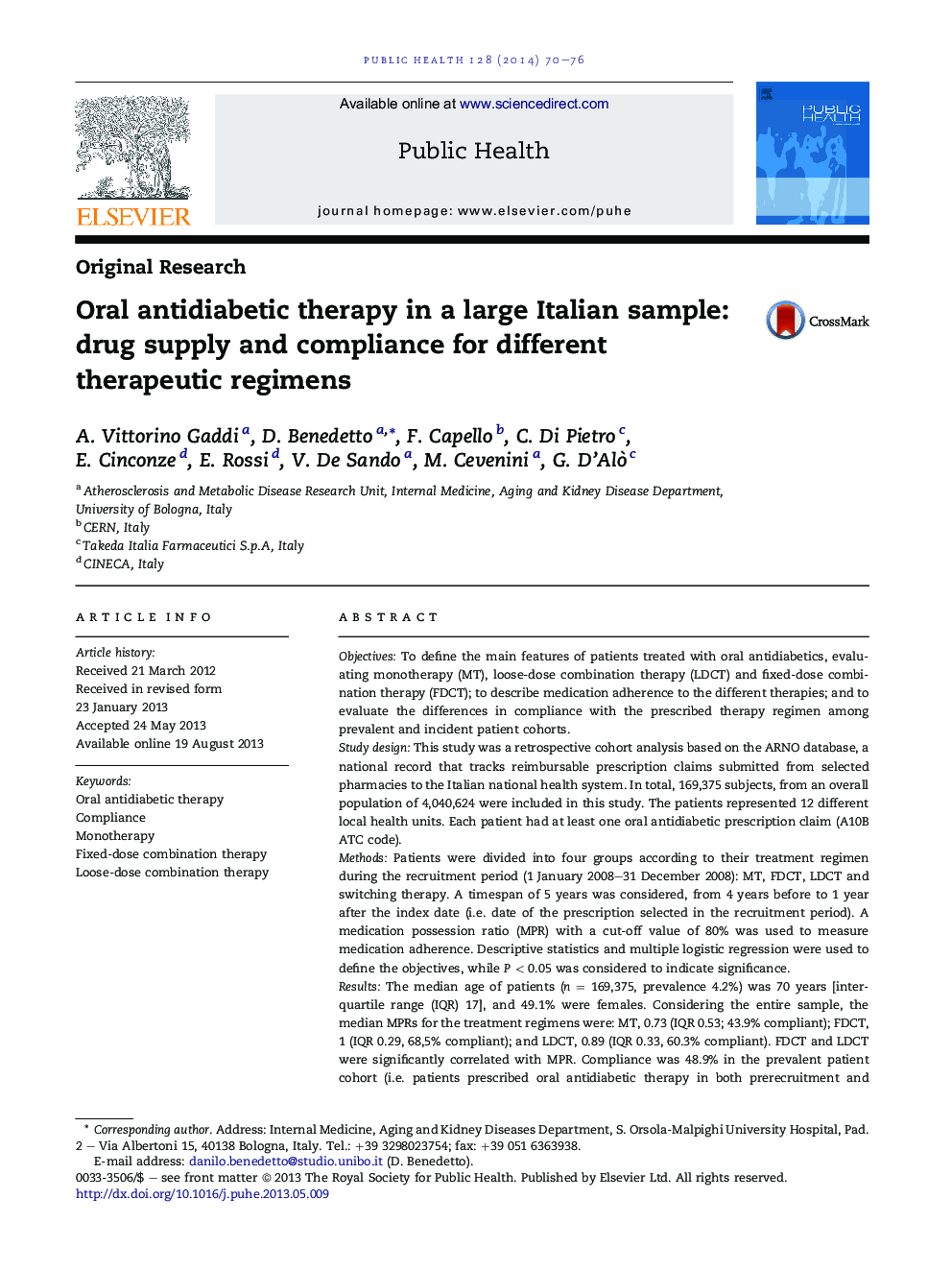| کد مقاله | کد نشریه | سال انتشار | مقاله انگلیسی | نسخه تمام متن |
|---|---|---|---|---|
| 1087560 | 951537 | 2014 | 7 صفحه PDF | دانلود رایگان |
ObjectivesTo define the main features of patients treated with oral antidiabetics, evaluating monotherapy (MT), loose-dose combination therapy (LDCT) and fixed-dose combination therapy (FDCT); to describe medication adherence to the different therapies; and to evaluate the differences in compliance with the prescribed therapy regimen among prevalent and incident patient cohorts.Study designThis study was a retrospective cohort analysis based on the ARNO database, a national record that tracks reimbursable prescription claims submitted from selected pharmacies to the Italian national health system. In total, 169,375 subjects, from an overall population of 4,040,624 were included in this study. The patients represented 12 different local health units. Each patient had at least one oral antidiabetic prescription claim (A10B ATC code).MethodsPatients were divided into four groups according to their treatment regimen during the recruitment period (1 January 2008–31 December 2008): MT, FDCT, LDCT and switching therapy. A timespan of 5 years was considered, from 4 years before to 1 year after the index date (i.e. date of the prescription selected in the recruitment period). A medication possession ratio (MPR) with a cut-off value of 80% was used to measure medication adherence. Descriptive statistics and multiple logistic regression were used to define the objectives, while P < 0.05 was considered to indicate significance.ResultsThe median age of patients (n = 169,375, prevalence 4.2%) was 70 years [interquartile range (IQR) 17], and 49.1% were females. Considering the entire sample, the median MPRs for the treatment regimens were: MT, 0.73 (IQR 0.53; 43.9% compliant); FDCT, 1 (IQR 0.29, 68,5% compliant); and LDCT, 0.89 (IQR 0.33, 60.3% compliant). FDCT and LDCT were significantly correlated with MPR. Compliance was 48.9% in the prevalent patient cohort (i.e. patients prescribed oral antidiabetic therapy in both prerecruitment and recruitment periods); median MPRs for the treatment regimens were: MT, 0.73 (IQR 0.52); FDCT, 1 (IQR 0.28); and LDCT, 0.90 (IQR 0.32). Compliance was 43.0% in the incident patient cohort (i.e. patients who were first prescribed oral antidiabetic therapy in the recruitment period); median MPRs for the treatment regimens were: MT, 0.70 (IQR, 0.58); FDCT, 1 (IQR 0.34); and LDCT, 0.64 (IQR 0.39).ConclusionsCompliance was better for FDCT than the other therapeutic regimens in the study population. The same trend was observed in both the prevalent and incident patient cohorts. As type 2 diabetes is a chronic lifelong pathology, and multiple agents are often required to achieve glycaemic control, the preference for FDCT in the population, when clinically applicable, could be an effective strategy for functional administration of clinical outcome and sources. Evaluation of specific population fractions (age, sex, compliance, etc.) and specific agents or drug combinations could also be relevant in order to reach the healthcare objectives.
Journal: Public Health - Volume 128, Issue 1, January 2014, Pages 70–76
